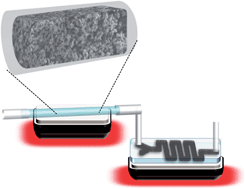Cationic imidazolium polymer monoliths for efficient solvent exchange, activation and fluorination on a continuous flow system†
Abstract
Polystyrene-imidazolium (PS-Im+Cl−) monolith was synthesized within a flow-through microfluidic chip and Teflon tubing for activating [18F]fluoride ions. The [18F]fluoride ions were trapped on the PS-Im+ monolith and were subsequently released with various phase-transfer catalysts (PTC) and carbonate or bicarbonate bases in microliter volumes of organic solvents containing 0.5% of water. The activated [18F]fluoride complex released from the PS-Im+ monolith was used to fluorinate various known PET probe precursors with diverse reactivity in a subsequent flow-through microfluidic chip without performing additional azeotropic distillation. The fluorination yields under the optimized condition for the protected [18F]FDG, protected [18F]FLT, 4-[18F]fluoroethylbenzoate, and [18F]fallypride were 93%, 96%, 77% and 73%, respectively. This method, utilizing the PS-Im+ monolith on a flow through microfluidic platform, enables the entire fluorine-18 radiochemistry to be performed on a flow-through microfluidic device within a shorter synthesis time and with fluorination efficiency that is comparable to or higher than conventional means.


 Please wait while we load your content...
Please wait while we load your content...